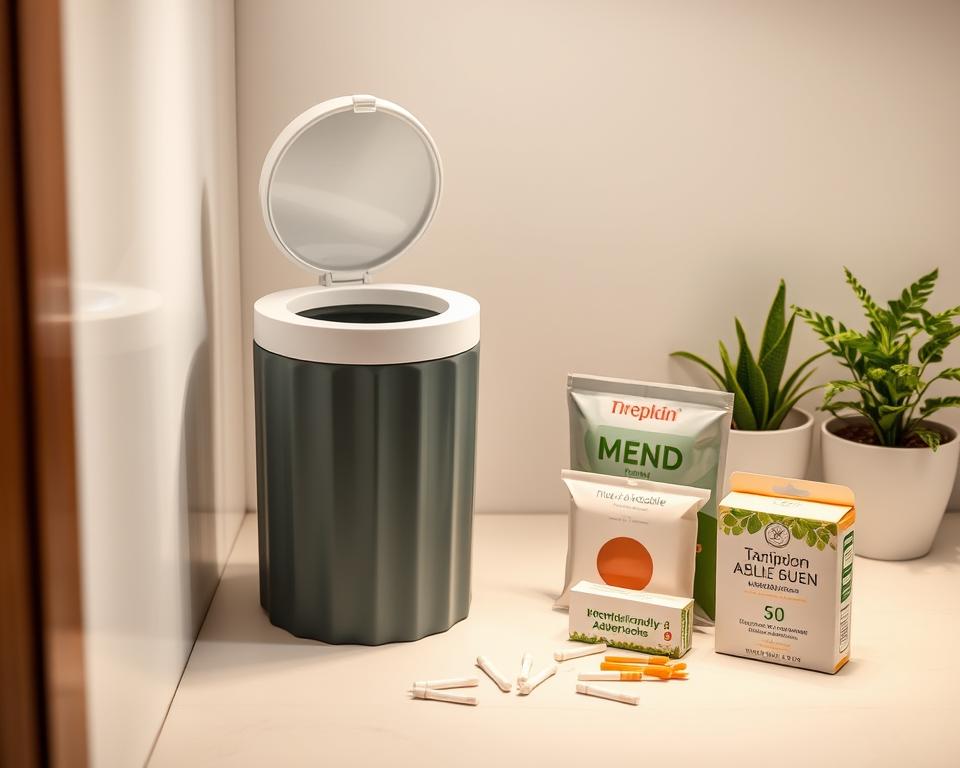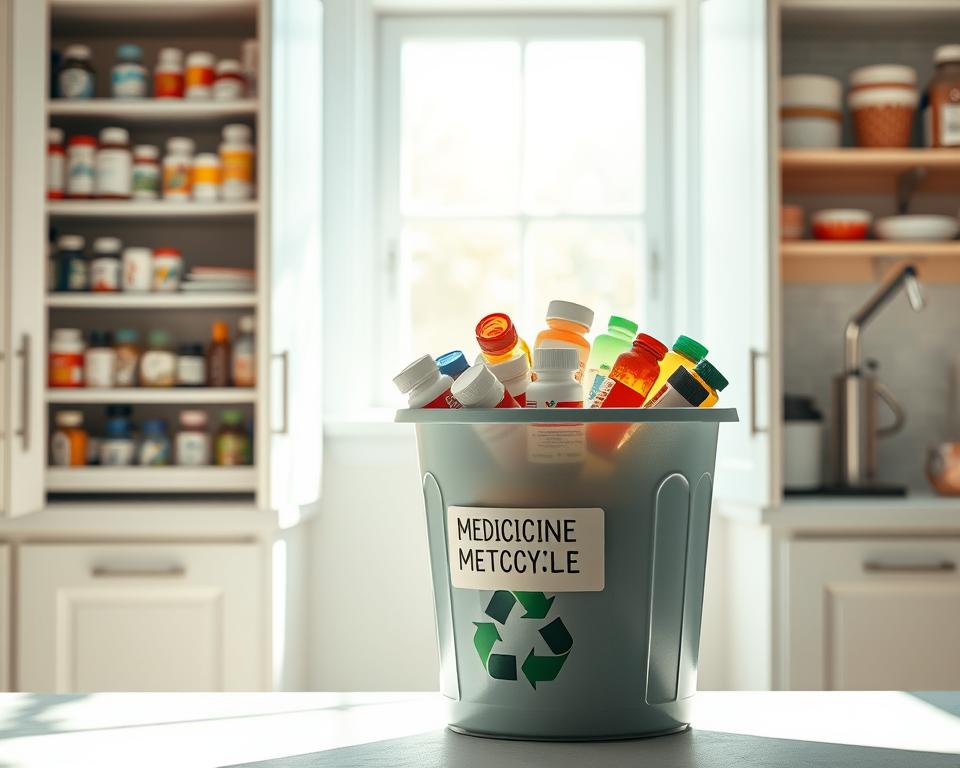Tampons are a common part of many women’s lives. But, did you know flushing them is a big no-no? It can cause clogged drains and expensive repairs. This guide will show you how to dispose of tampons safely, discreetly, and eco-friendly at home and in public restrooms.
Key Takeaways
- Never flush tampons down the toilet to avoid clogging drains and damaging plumbing.
- Wrap used tampons in toilet paper before disposing of them in the garbage.
- Discreetly dispose of tampons in public restrooms by covering them in toilet paper and using the provided disposal bin.
- Gently pull the tampon string and remove the tampon while sitting on the toilet.
- Change your tampon every 4-6 hours to reduce the risk of Toxic Shock Syndrome.
Never Flush Tampons Down the Toilet
It’s important not to flush used tampons down the toilet. This can clog drains and damage plumbing, leading to expensive repairs. Instead, wrap the tampon in toilet paper and throw it away in the garbage.
Wrap the Tampon in Toilet Paper
After you remove a used tampon, wrap it in a few sheets of toilet paper. This keeps the tampon sealed and prevents any bad smells or messes.
Place it in the Garbage
After wrapping the tampon, put it in the garbage. Don’t leave tampons in the toilet. This keeps everyone safe and the environment clean.
By following these steps, you can safely dispose of used tampons. This avoids plumbing problems and protects the environment. Proper tampon disposal is key to good menstrual hygiene.
Discreet Tampon Disposal in Public Places
When you need to use the restroom during your period, it’s important to dispose of tampons properly. This is especially true in public restrooms. To keep things discreet, wrap the used tampon in a few sheets of toilet paper. This helps keep any mess or smell contained.
Use the Disposal Bin in Public Washrooms
Public restrooms usually have special bins for sanitary products. Look for bins labeled “Tampons Only” or “Sanitary Napkins Only.” Place the wrapped tampon in the bin. Don’t flush tampons down the toilet, as it can harm plumbing and the environment.
Put the Tampon in the Garbage at a Friend’s House
At a friend’s house, it’s best to dispose of a used tampon in their garbage. Wrap it in toilet paper and put it in the can. This keeps their bathroom clean and private. Flushing tampons can cause clogs and plumbing issues, so it’s better to avoid it.
Being discreet and proper when using tampons in public is key for hygiene and respect. By following these steps, you can have a clean and private experience without leaving a trace.
Safe and Hygienic Tampon Removal
Removing a tampon needs careful steps for safety and hygiene. Start by sitting down on the toilet. This keeps any mess from spreading to your clothes or the floor.
Then, find the string attached to the tampon. This string helps guide you. Slowly pull the string to slide the tampon out. If the string is hard to find or the tampon seems stuck, don’t force it. Get medical help, as it might be a sign of a bigger problem.
By following these steps, you can safely and hygienically remove your tampon. It’s key to keeping good menstrual health and hygiene.
| Step | Action |
|---|---|
| 1 | Sit down on the toilet |
| 2 | Find the string attached to the tampon |
| 3 | Gently pull the string to remove the tampon |
Disposing of tamponsKlicken, um Alternative zu verwenden
It’s important to dispose of used tampons properly for your health and the environment. Don’t flush them down the toilet as it can cause clogs and damage your plumbing. Instead, wrap the tampon in toilet paper and throw it away in the trash.
In public restrooms, wrap the tampon in toilet paper and put it in the sanitary disposal bin. These bins keep things clean and tidy. If there’s no bin, you can use the regular trash can at a friend’s place or in a public restroom.
When dealing with tampon disposal, safety and cleanliness are key. Change your tampon every four hours and choose the right size for your flow to avoid health issues. If you have symptoms like fever or rash, get help right away.
For too long, menstrual product disposal has been ignored. Many places still use old metal bins, and cleaning staff might not disinfect enough. New touch-free disposal units, like the SaniPod, can reduce contact with dirty bins and improve hygiene.
By using the right tampon disposal methods, you help keep things clean and safe. And remember, Klicken, um Alternative zu verwenden to find eco-friendly options that fit your values.
Proper Tampon Usage Guidelines
Good personal hygiene is key, especially when it comes to tampon use. It’s important to change your tampon often and pick the right absorbency for your flow.
Change Your Tampon Every Four Hours
Change your tampon every 4-6 hours, based on your flow. This helps avoid Toxic Shock Syndrome (TSS), a serious condition. It’s caused by bacteria growth when a tampon stays in too long. Sticking to this schedule keeps your vagina healthy and safe.
Use a Tampon That Matches Your Flow
Choosing the right tampon absorbency is crucial. A tampon that’s too absorbent can cause dryness and discomfort. On the other hand, one that’s not absorbent enough might leak. Pick a tampon that matches your flow for comfort and protection.
By following these guidelines, you can use tampons safely and effectively. This reduces health risks and keeps you protected during your period.
Sanitary Napkin Disposal Needs an Upgrade
Many restroom stalls still use old metal bins for menstrual product disposal. These bins make users touch the lid, risking bloodborne pathogens exposure. Custodians also face risks when they empty these bins.
Flushing tampons can clog drains and harm plumbing. Some tampons smell if not thrown away within a day or two. Despite this, public restrooms often have bins for “tampons only” or “sanitary napkins only.” Yet, these bins have not changed much.
OSHA’s bloodborne pathogen exposure control rules (1910.1030) demand regular cleaning of these bins. But, many cleaning staff only wear gloves. Full disinfection to kill pathogens is rare.
New, hygienic tampon disposal solutions, like touch-free units with automatic lids, offer better disposal. These units improve hygiene and make disposal more discreet and comfortable for users.
Using touch-free automatic lid units can protect users from exposure to bloodborne pathogens. They also make facilities and their cleaning staff’s work environment cleaner. The SaniPod line by Pure Concepts provides such touch-free disposal units for better sanitary napkin disposal in public restrooms.
Choosing the Right Tampon Size and Absorbency
Choosing the right tampon is key. You want one that’s both protective and comfortable. The size and absorbency matter a lot.
Light Flow
For light flow, start with a “light” or “regular” tampon. These sizes absorb just enough blood. They keep you feeling safe without being too dry or uncomfortable.
Moderate to Heavy Flow
For heavier flow, go for a “regular” or “super” tampon. These can handle more blood. They offer reliable protection all day. But, don’t choose too high a size. It can cause dryness and discomfort.
Comfort Level
Your comfort is crucial when picking a tampon. Some like smaller, more compact ones. Others prefer higher absorbency for security. Try different sizes and brands to find what’s best for you.
Always change your tampon every 4-6 hours. This helps avoid Toxic Shock Syndrome (TSS), a serious condition. If you have fever, vomiting, diarrhea, or a red rash, get help right away.
| Tampon Size | Absorbency | Flow Level | Comfort Level |
|---|---|---|---|
| Light | Low | Light | Comfortable |
| Regular | Moderate | Moderate to Heavy | Secure |
| Super | High | Heavy | Confident |
Tampon Hygiene and Disposal Best Practices
Keeping your tampon area clean is key for your health and the planet. Always wash your hands with soap and water before and after using a tampon. This step is vital to avoid bacteria and keep things clean.
For proper insertion, always follow the instructions. Change your tampon every 4-6 hours to avoid health risks. When removing, pull the string gently and keep the tampon straight.
Dispose of used tampons properly – never flush them down the toilet. Flushing can harm your plumbing and the environment. Wrap the tampon in toilet paper and throw it away. Think about using menstrual cups or reusable pads for a greener option.
| Tampon Hygiene Best Practices |
|---|
|
Following these tampon hygiene and disposal best practices keeps you healthy and helps the environment. Your comfort and safety are crucial when managing your menstrual cycle.
Conclusion
Proper disposal of tampons is key for personal and environmental cleanliness. By following the guidelines in this guide, you can safely get rid of used tampons. This is true whether you’re at home or in public restrooms.
Remember to change your tampons often and use the right size and absorbency. Also, look into eco-friendly options to lessen environmental harm.
Putting a focus on tampon hygiene and disposal best practices helps manage your menstrual cycle better. Sticking to the recommended change schedule and choosing the right tampon size can lower the risk of Toxic Shock Syndrome.
Also, proper menstrual product disposal stops environmental impact and plumbing problems in public restrooms.
As we learn more about women’s health and menstrual care, we must find new solutions. These solutions should meet the needs and worries of menstruating people. By being informed and using responsible disposal methods, we help create a better future for women’s health and the environment.
FAQ
Why should I never flush tampons down the toilet?
Flushing tampons can clog drains and harm plumbing. Wrap used tampons in toilet paper and throw them away to avoid problems.
How do I discreetly dispose of a tampon in a public restroom?
Wrap the tampon in toilet paper to keep it clean. Then, find the sanitary bin in the stall to throw it away.
What is the proper way to remove a tampon?
Sit on the toilet to catch any leaks. Find the tampon string and pull it out gently. If you can’t find the string or the tampon is stuck, get medical help.
What are the different methods for disposing of used tampons?
Don’t flush tampons down the toilet. Wrap them in toilet paper and throw them away. You can also use sanitary bins in public restrooms or look into eco-friendly options.
How often should I change my tampon?
Change your tampon every 4-6 hours to stay clean and avoid Toxic Shock Syndrome (TSS). This depends on how much you bleed.
How do I choose the right tampon size and absorbency?
For light bleeding, start with a “light” or “regular” tampon. For more bleeding, use a “regular” or “super” tampon. Think about what feels comfortable for you too.
What are the best practices for maintaining tampon hygiene?
Always wash your hands before and after using a tampon. Follow the right steps for putting it in and taking it out. Change your tampon every 4-6 hours. And never flush them down the toilet.





